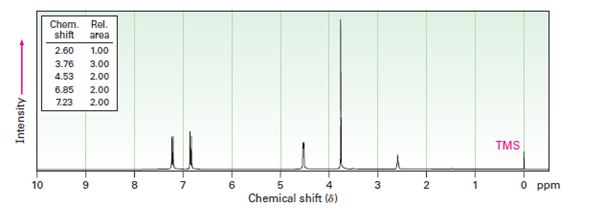
Concept explainers
Interpretation:
A structure for the alcohol with molecular formula C9H12O and the following spectral data is to be proposed.
1HNMR: 0.88 δ (triplet,Rel.area=3.00); 1.80 δ (quintet, Rel.area=2.00); 2.32 δ (Rel.area=1.00); 4.54 δ (triplet, Rel.area=1.00); 7.24 δ (Rel.area=5.00).
Concept introduction:
In 1HNMR spectrum, the alcoholic proton absorption occurs in the range 3.4 δ - 4.5 δ while that of phenolic proton occur in the range 3.0 to 8.0. The
The absorption due to 10 alkyl group (CH3) is seen around 0.7 δ - 1.3 δ, that due to a 20 alkyl group (CH2) is seen around 1.2 δ - 1.6 δ while that due to 30 alkyl group (CH) is seen around 1.4 δ - 1.8 δ The multiplicity of a signal gives an idea about the protons present in the adjacent carbons.
To propose:
A structure for the alcohol with molecular formula C9H12O and the following spectral data is to be proposed.
1HNMR: 0.88 δ (triplet,Rel.area=3.00); 1.80 δ (quintet, Rel.area=2.00); 2.32 δ (Rel.area=1.00); 4.54 δ (triplet, Rel.area=1.00); 7.24 δ (Rel.area=5.00).
b)
C8H10O2

Interpretation:
A structure for the alcohol with molecular formula C8H10O2 and the following spectral data is to be proposed.
IR: 3500 cm-1,
1HNMR: 2.60 δ (Rel.area=1.00); 3.76 δ (Rel.area=3.00); 4.53 δ (Rel.area=2.00); 6.85 δ (Rel.area=2.00); 7.23 δ (Rel.area=2.00).
Concept introduction:
In 1HNMR spectrum, the alcoholic proton absorption occurs in the range 3.4 δ - 4.5 δ while that of phenolic proton occur in the range 3.0 to 8.0. The aromatic protons give a broad peak in the range 6.5 δ - 8.0 δ, the benzylic protons normally absorb in the region 2.3 δ - 3.0 δ.
To propose:
A structure for the alcohol with molecular formula C8H10O2 and the following spectral data is to be proposed.
1HNMR: 2.60 δ (Rel.area=1.00); 3.76 δ (Rel.area=3.00); 4.53 δ (Rel.area=2.00); 6.85 δ (Rel.area=2.00); 7.23 δ (Rel.area=2.00).
Trending nowThis is a popular solution!

Chapter 17 Solutions
EBK ORGANIC CHEMISTRY
- Can the target compound at right be efficiently synthesized in good yield from the unsubstituted benzene at left? ? starting material target If so, draw a synthesis below. If no synthesis using reagents ALEKS recognizes is possible, check the box under the drawing area. Be sure you follow the standard ALEKS rules for submitting syntheses. + More... Note for advanced students: you may assume that you are using a large excess of benzene as your starting material. C :0 T Add/Remove step Garrow_forwardThe following equations represent the formation of compound MX. What is the AH for the electron affinity of X (g)? X₂ (g) → 2X (g) M (s) → M (g) M (g) M (g) + e- AH = 60 kJ/mol AH = 22 kJ/mol X (g) + e-X (g) M* (g) +X (g) → MX (s) AH = 118 kJ/mol AH = ? AH = -190 kJ/mol AH = -100 kJ/mol a) -80 kJ b) -30 kJ c) -20 kJ d) 20 kJ e) 156 kJarrow_forwardA covalent bond is the result of the a) b) c) d) e) overlap of two half-filled s orbitals overlap of a half-filled s orbital and a half-filled p orbital overlap of two half-filled p orbitals along their axes parallel overlap of two half-filled parallel p orbitals all of the abovearrow_forward
- Can the target compound at right be efficiently synthesized in good yield from the unsubstituted benzene at left? starting material target If so, draw a synthesis below. If no synthesis using reagents ALEKS recognizes is possible, check the box under the drawing area. Be sure you follow the standard ALEKS rules for submitting syntheses. + More... Note for advanced students: you may assume that you are using a large excess of benzene as your starting material. C T Add/Remove step X ноarrow_forwardWhich one of the following atoms should have the largest electron affinity? a) b) c) d) 으으 e) 1s² 2s² 2p6 3s¹ 1s² 2s² 2p5 1s² 2s² 2p 3s² 3p² 1s² 2s 2p 3s² 3p6 4s2 3ds 1s² 2s² 2p6arrow_forwardAll of the following are allowed energy levels except _. a) 3f b) 1s c) 3d d) 5p e) 6sarrow_forward
- A student wants to make the following product in good yield from a single transformation step, starting from benzene. Add any organic reagents the student is missing on the left-hand side of the arrow, and any addition reagents that are necessary above or below the arrow. If this product can't be made in good yield with a single transformation step, check the box below the drawing area. Note for advanced students: you may assume that an excess of benzene is used as part of the reaction conditions. : ☐ + I X This product can't be made in a single transformation step.arrow_forwardPredict the major products of this organic reaction:arrow_forwardCalculate the density of 21.12 g of an object that displaces 0.0250 L of water.arrow_forward
- Draw the expected reactant R28. Cu(II) CO₂Mearrow_forwardPpplllleeeaaasssseeee helllppp wiithhh thisss Organic chemistryyyyyy I talked like this because AI is very annoyingarrow_forwardName the family to which each organic compound belongs. The first answer has been filled in for you. compound CH₂ || CH3-C-NH2 0 ။ CH3-C-CH₂ CH=O–CH=CH, CH₂ HO CH2-CH2-CH-CH3 family amine Darrow_forward

 Organic ChemistryChemistryISBN:9781305580350Author:William H. Brown, Brent L. Iverson, Eric Anslyn, Christopher S. FootePublisher:Cengage Learning
Organic ChemistryChemistryISBN:9781305580350Author:William H. Brown, Brent L. Iverson, Eric Anslyn, Christopher S. FootePublisher:Cengage Learning

